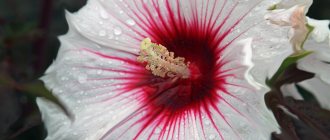The small, pale pink, single flowers cannot compare to the beautiful, large flowers of noble roses, but the wild rose has a number of other advantages . Its fruits are a source of a large number of vitamins and nutrients; it is not for nothing that they have been used in herbal medicine for many years. Meet the wild rose (rose hip).
Wild rose - what kind of flower is it?
The second and most common name of the flower is rosehip. In total, there are more than 75 varieties of this shrub, which is surprising, since most people know and have seen no more than 4-5 varieties.
Rosehip berries
The plant belongs to the Rosaceae family. Almost all types of common rose hips can be found in all regions of the country, with rare exceptions.
Interesting! You can tell the time by the wild rose, as its flowers open and close almost like clockwork.
Description of what it looks like
Description of wild rose:
- life form - bush;
- the stems are most often green, covered with many small thorns;
- the flowering period lasts from the second half of May and ends in mid-summer;
- the fruits ripen in September;
- the flower is simple, with many stamens;
- the color depends on the variety - from white to bright pink;
- The colors of the fruits are also varied.
Since rosehip is a monoecious plant, it requires a partner for pollination, otherwise there will be no fruit. Self-pollination rarely occurs; more often, the attraction of pollinating insects is required, which willingly flock to the pleasant, bright aroma of the flower.
Healing properties, use on the farm
The fruits of the plant have healing properties and help with colds, coughs, and bronchitis. You can simply add them to tea, brew them as a stand-alone drink, or make a compote from them to strengthen your immune system.
For reference! The berries of the plant contain a huge amount of vitamin C.
Beautiful and useful - the use of rose hips
Wild rose, Rose hip (Rosa canina) is a fairly versatile shrub that can have many different uses. Its fruits are an unusually rich source of vitamins (mainly a huge amount of vitamin C, as well as vitamins A, E, B1, B2, K) and many valuable nutrients (tannins, flavonoids, organic acids, pectins, glucose, carotenoids in including lycopene, polyphenol, mineral salts, essential oils), therefore they are used for making jams, preserves, juices, syrups, tinctures, wines, and in dried form - for making fruit teas.
Flower petals are an ideal raw material for preparing wonderful rubs and scented essential oils. Dried petals are also a component of aromatic compositions such as potpourri .
Rosehip is also a valuable, ornamental garden shrub that can be used to create protective hedges or groups of ornamental shrubs. The plant is ideal for naturalistic style gardens, but is also suitable for romantic, English, country and traditional gardens, and even modern style gardens.
Red fruits are an interesting, bright accent in the autumn garden, and their decorative value is even more noticeable in winter, as they remain on the branches for a long time after the leaves have fallen. The fruits can also be an ideal winter food for birds, which will also find shelter in the dense thorny branches.
Varieties of wild roses for growing in the garden
Wild rose bushes are often grown to decorate courtyards and park areas; they are planted as hedges and in garden plots.
A flower that looks like a hydrangea - what is it called?
The shrub is especially liked by overly busy gardeners who want their garden to look as attractive as possible despite the minimum effort expended.
Dog rose (Canina)
The most common type of shrub, most often used to create living fences.
Bright pink, large, fragrant flowers bloom in early summer, and closer to autumn the berries begin to ripen. Maximum height - 3 m.
For reference! This plant is very unpretentious, it requires virtually no care.
French (Gallica)
French rose hips grow only in the southern parts of Russia and European countries.
The bush is low-growing, the height of the stems does not even reach 1 m. The flowers are bright red.
Can be grown as a houseplant.
French rosehip
Devil's Rose Lakorn
This bush proved that even a simple rose hip can have such a threatening name.
This low-growing plant has no thorns at all on its thin long stems. The peduncles are long and bear large bright flowers. There are small sticky droplets on the fruits and stalks that give Lakorn its original appearance.
Moyes Wild Rose
Moyes rose includes several ornamental flowers with large bottle fruits and bright red, very showy flowers.
The leaves are bright green, against their background the flowers look especially impressive.
Wild rose Althea
The Althea variety is a perennial herbaceous shrub reaching 2 m in height.
The root system is very powerful, there are no thorns, instead the stems and leaf petioles are covered with villi.
The flowers are large, white-pinkish in color, located on short peduncles.
Variety Althea
rust rose
This plant has the appearance of a shrub with an average height of about 1.5 m, but can grow up to 2.5 m.
The stems are covered with large thorns. The leaves are green, up to 12 cm, with 7 leaflets.
The flowers are pale pink. The fruits are red, spherical in shape.
Rose Hugonis
This is a wild yellow rose that blooms first among all varieties.
The flowers are pale yellow, located on short stalks throughout the shoot. It has many thorns and has high immunity. It grows very quickly, growing up to 250 cm.
Rosa Hugonis
In addition to those presented, flower growers also grow other varieties of rose hips; one of the most common ones is the wild white rose, as well as cinnamon rose hips.
Tea rose - varieties, planting, care secrets, home species (101 photos + video)
There is probably not a single amateur or professional gardener who has not at one time in his life been interested in growing tea roses. And of course, an important definition in the matter of choice is the mission of the rose in the overall plot.
Among the ever-expanding list of varieties, shining with a variety of shapes, hardiness, color and stability, it becomes easier to choose the right option. But even the most romantic natures prefer not modern cold flowers, but roses with imprints of the past - Gallic, French, Damask, etc.
Pay attention to the photo of tea roses. Nowadays, these “old” varieties have inspired the most original flower breeders to create new masterpieces, preserving their best qualities. For example, roses of Guillot and D. Austin.
In general, the class of tea roses has not undergone significant changes from the actions of breeders, but some romantic types of roses with an abundance of inflorescences, amazing aroma and beautiful appearance, still did not go unnoticed and fulfilled their mission in the historical development of many varieties and are now popular among professionals and ordinary rose lovers.
Roses were first imported in 1810 from China. In the southern territory of China, the rose still exists in its original form. This is an evergreen bush plant with long thin branches on which flowers are arranged individually or in groups of 2-3 with a rich scent of fresh tea.
Yes, that is why roses were called tea roses, and not because of their Chinese origin. Sometimes the tea rose is called Chinese, most often this is found in literary works.
Although there are scientific sources claiming that tea is a hybrid of Chinese tea, which does not have the original tea aroma.
To develop new products, both versions of the rose were used, but the fragrant rose is still considered the source.
The main disadvantage was its inability to live in harsh climates and vulnerability to disease. Therefore, breeders began to create varieties that are more stable and different in height (short up to 50 cm and climbing up to 2-4 m), which take root at temperatures no higher than -26°C, but require special maintenance.
Today, the low level of frost resistance remains the most pressing drawback of tea roses.
In addition to these shortcomings, breeders were plagued by some other difficulties in propagating roses. To do this, the breeder needed to grow at least 200 seedlings and root the cuttings, but this ended in constant failure.
A way out of the difficult situation was found by Guillot Jr., who invented eye grafting onto wild shrubs so that it would be effective and efficient. In the history of the development of tea roses, this became a significant event and historical fact, which was immediately accepted by all flower lovers.
"Madame Falcot" - one of the first-born, served as a lady's decoration in Napoleonic times, "Duchesse de Brabant" - T. Roosevelt's favorite, gracefully sitting on his coat, Chekhov's "White Dacha" was decorated with 68 pink varieties, half of them belonged to tea varieties.
“La France” is a variety bred by Guillot Jr., its best varieties subsequently became active participants in many hybridization processes.
Unfortunately, many ancient varieties can be seen with your own eyes in museums or in private rose gardens, which is why the cultivation of such ancient varieties by domestic flower growers is heroic.
Growing wild roses in open ground
Growing a wild rose and planting it does not cause much trouble for the gardener; it is a rather unpretentious plant.
What time does boarding take place?
What is the name of an indoor flower with red leaves?
Young plants can be planted at any time.
But if spring planting is planned, then the soil on which the rose hips will grow should be fertilized with organic fertilizers.
It is best to plant wild roses in open ground in early spring, when young shoots have grown only 15-20 cm.
Selecting a location
Shrubs can be placed anywhere, but in shaded areas flowering will not last too long, and fruits may not form at all.
It is also worth remembering the speed of growth of wild roses, so it is worth preparing a large area for it in advance, since replanting it will be difficult.
How to prepare the soil and flower for planting
The soil should first be fertilized and the planting hole prepared. The roots of the seedling are treated with a solution of potassium permanganate or any other disinfectant.
Since the root system of the bush is fibrous, it is worth carefully examining all the roots, removing rotten and damaged ones, and sprinkle the cut areas with charcoal. The main roots are shortened a little, literally by a few cm.
Important! The soil should not be saline or waterlogged. It is better if the groundwater is not located too high.
Step by step landing procedure
- A hole 50x50x50 cm is prepared for each plant.
- 10-15 kg of compost, 200 g of superphosphate, a little potassium chloride and ammonium nitrate are added to each pit.
- The ground part of the seedlings is significantly shortened, only small shoots remain, the maximum height of which is 15 cm.
- 10 liters of good, settled water at room temperature is poured into each hole.
- Prepared seedlings are placed in the hole and sprinkled with soil. In this case, there should not be a lot of top layer - the layer is slightly greater than the depth to which the bush was deepened in the planting container (about 5 cm).
- Next, the rose hips are watered, the soil is slightly compacted and mulched with sawdust, peat or moss.
Planting rose hips in open ground
Appearance of the bush
White rosehip is a shrubby plant. Upright, it looks very picturesque and graceful - arched branches, studded with white flowers, widely spread and hanging. Deciduous and fast-growing, it has a height of 2-3 meters, less often 5, and a width of 3 meters. The bark of this shrub is brownish and reddish-green, the shoots come with a small number of thorns or without them at all. The leaves of the white rose hip are alternating, in addition, they are imparipinnate - the branch ends with a leaf that does not have a pair. Their length varies from 5 to 10 centimeters, width - from 2 to 3 cm. There can be from 7 to 9 of them on a branch. The upper part of the leaf is usually green and shiny, while the lower part is dull. The leaves are slightly pubescent and do not fall off for a long time.
Plant care
Wild rose does not require additional care. This is an option for novice gardeners and for those who do not have a lot of time to care for all the plantings in the garden.
- Watering rules and humidity
What is the name of an indoor flower with red flowers?
Rosehip is an amazing plant that can easily adapt to hot, dry weather. But still, during a period of special drought, you can water the flower, but 10-15 liters of water are poured under each bush, no more.
Attention! You should not water a wild rose more than 3 times during the season.
- Fertilizing and soil quality
The flower needs feeding only in the first years of life; it needs both mineral and organic fertilizers.
The main thing is not to overdo it with nitrogen, otherwise problems with flowering may begin.
- Pruning and replanting
The first drastic pruning is done after planting, if the shoots were not shortened initially. Then only formative pruning is required once every 3 years.
- Features of wintering a flower
Most species tolerate winters, even harsh ones, calmly.
But if a delicate, southern variety is grown in the garden, so that in the spring it looks and feels perfect again, it will need to be covered with a special protective material.
Which ones are considered the most medicinal?
Not all varieties of rose hips have medicinal properties; about 30 species with different compositions are used for medicinal purposes. The most often used for medicinal raw materials are the varietal varieties of May or cinnamon, needle, wrinkled and Daurian species, due to the high content of vitamin C and pronounced antioxidant, immunomodulatory, tonic and wound-healing properties.
These are the varieties:
- "Anniversary";
- "Hedgehog";
- "Lights of Samara";
- "Terneysky";
- "Geisha";
- "Vitamin."
Some components
Although they say that it is becoming a thing of the past, and is being replaced by various nutritional gels, the chatterbox is still quite in demand. Then we straighten the roots and install the seedling so that the rhizome drops 5-8 cm below the soil surface. Next, you need to fill the roots with prepared soil, water it with water and sprinkle the planted seedling with sawdust or peat.
Specialized stores have a very large selection of seedlings of all popular types of rose hips. It is necessary to specify the distance between planted plants. If you are making a hedge, 50 centimeters between the holes will be quite enough. If the bush is planted in order to obtain abundant fruit harvests, there should be much more space around the bush. It should be added that vitamin varieties are planted only vegetatively (a method of asexual reproduction, when a new one is obtained from a multicellular part of the body of the parent) - by grafting, cuttings and layering.
Rules for planting seedlings
White rosehip seedlings, like any other, take root best when planted in autumn. It is recommended to plant them in October or November. How does this happen?
First you need to dig a hole 20-22 centimeters deep. It is advisable to treat the soil - if it is acidic, you need to add lime fertilizer. Add rotted manure and compost to the same hole. There are certain landing rules. So, before planting, the seedling is cut so that the thick branch is no longer than 8-10 cm; root cuts are also made up to 10-15 cm. Before planting the seedling in the hole, we dip the rhizome in a clay mash so that the roots do not dry out.
Collecting, drying and storing fruits for the winter
The fruits begin to ripen at the end of August. Ripe rose hips are harvested by hand. The fruits are sorted, cleared of debris and sepals are removed and immediately sent for drying in a special dryer or oven. Properly dried rose hips can be stored for up to 2 years.
More detailed information about collecting and preparing plants at home can be found here.
Giver of love
The wild roses described here also include the white rose hip Rosa Alba. This is the same “culprit of passion” glorified in the legendary Lenkomov performance - a bush with simple white flowers.
It should be noted that it was about him, about the white rose hip with its magical ability to arouse love in the hearts of people, that was written in various medieval books with conspiracies.
There was such a mysterious person as Milokh Zaruzhny, who in his “works” wrote that if two people are scratched on the same white rose hip branch, then the mutual passionate feeling that flared up will survive centuries, because only this plant is capable of forever binding the hearts of even the most different of people. Love potions are prepared from it, which can evoke tenderness and passion.
And if you collect branches of white rose hips during the full moon in November, dry them and wear them as a talisman, then neither a vampire nor a sorcerer will be able to suck blood or energy out of a person. And a talisman made from a mixture of flowers or twigs of white rose hips, hawthorn berries, branches or pine cones becomes completely omnipotent. Rosehip with white flowers heals the heart, cleanses and restores the blood, and gives people love, peace and happiness.











